In today’s post, I’m going to attempt one of Gordon Ramsay’s recipes. It’s called “Crispy Salmon With Crushed New Potatoes.” I was initially attracted to this recipe because, for one, I love salmon and two, I love any sort of potato salad. This recipe seemed to fit the bill.
Now, as you’re most likely aware, I’m new to cooking. With this “newness” comes many questions. And it seems as though my questions began rather early with this recipe. Let me first jot down the ingredients we’ll need here because it’ll help explain what I’m about to ask below.
Ingredients
4-6 Peeled New Potatoes
Olive Oil (Extra Virgin + Pure)
One Bunch Green Onions (Scallions)
Salt & Pepper
Vinaigrette (Olive Oil, Water, Lemon Juice)
1/2 Cup Chopped Parsley
12 Ounces of Crab Meat
2-4 Plum or Grape Tomatoes
2-3 Salmon Fillets with Skin On
Questions
Below, I’ll list my questions. I’ll start off short and sweet, but I’m sure my list and verbosity will grow as I progress through this recipe.
1. What is a New potato?
As I was in the grocery store a few days ago, looking for “New” potatoes, I quickly became stumped. I couldn’t find them. There were many types of potatoes to choose from, so since I couldn’t find the exact ingredient the recipe called for, I grabbed smaller “Gold” potatoes, hoping that they would suffice. I watched Gordon prepare this recipe and I imagined that my potatoes looked like his. The thing is, even after I settled on the potato I purchased, I still wanted to know what New potatoes were.
Apparently, “New” potatoes aren’t of any particular variety. They merely refer to the freshly harvested potatoes of a new season. They can be red or white or gold. They’re characterized by a thinner, more translucent, more papery skin. Think of those small red potatoes that are so familiar and then apply that same skin type and size to other varieties of New potatoes.
I believe I did well with my choosing because, even though my potatoes fall under the “Gold” label, I believe they’re “New” as well. They’ve got the necessary characteristics.
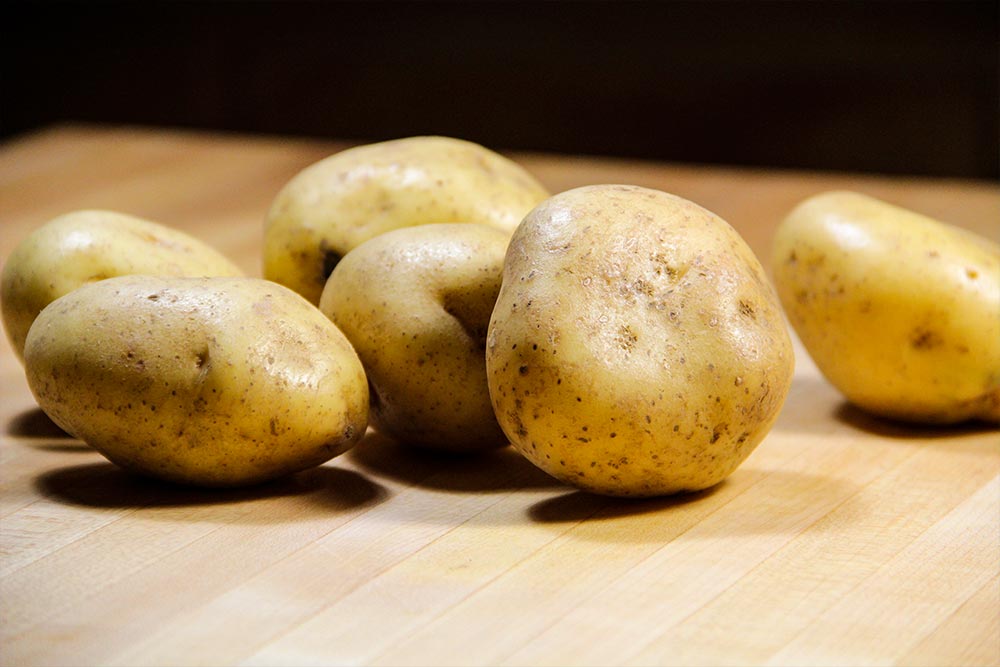
2. Do you peel the potatoes before or after you boil them?
Gordon’s recipe calls for “boiled and peeled” potatoes. My question is, which one comes first? I know that peeling a potato before boiling is most likely going to be a much cleaner operation than attempting to peel it afterwards. After is when the potato is soft. I’m not sure I can peel it then. It’s also going to be hot. Do I want to touch and peel a hot, or even warm, potato?
I looked this one up as well and found a wide variety of input. I’d have to say that folks are split 50/50 out there in regards to whether they peel before of after. The issue of “nutrients in the skin” came up a few times, but I’m not concerned about that right now. I simply want to get through this recipe without messing things up too badly.
Some commenters claim that once you boil a potato, it’s skin will slide right off. Others said that they most certainly peel first because of the unseen hazards that await them after boiling. I think I’m on their side, so I’m going to peel before I boil. What I was really looking for was a decisive answer one way or another. Since it’s so split, I’m confident that I’m not making a grievous error.
3. Can you leave the skins on the potatoes?
If I wasn’t posting this recipe here, I’d leave the skins on these potatoes. I always do. I prefer them like that. Plus, it’s true – that’s where the nutrients are.
Step-by-Step Instructions
This is where I go through each step I took to create this work of art. I’ll attempt to offer as much clarity as possible.
Boiling the Potatoes
I decided to go with six potatoes because I thought I’d like more food as compared to less. I peeled the potatoes and then added them to cool, salted water. I turned the stove on high and once the water began boiling, I turned the burner to low and covered the pot.
How long you let the potatoes boil depends on how large they are. The bigger the potato, the longer it needs to boil. In my case, since they weren’t all too large, I let them boil between 20-25 minutes. I also cut the bigger ones in half before I added them to the pot. Once I had an inkling they were almost finished, I began gently sliding a knife through them. When I felt little to no resistance, I drained the water and transferred them to this bowl below. If you look closely, you can see the steam rising from them, which I think is pretty cool.
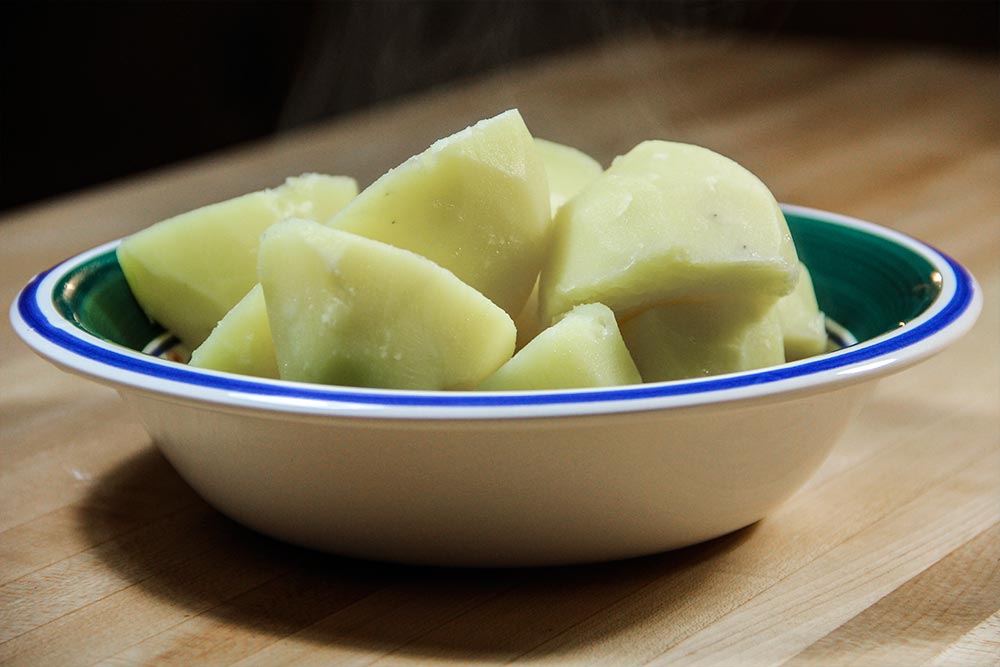
Adding the Potatoes to Olive Oil
In a saucepan, I heated up some extra virgin olive oil. I’d say probably about three tablespoons. If you love olive oil, I welcome you to add a bit more. The reason I used “extra virgin” olive oil is because of its flavor. The mixture of the oil and the potatoes isn’t about cooking the potatoes, it’s about adding flavor to them.
The primary goal was to merely heat the oil up and add the already warm potatoes to it. Since the potatoes were warm, they didn’t stick at all.

After I rolled the potatoes around a bit in an effort to coat them with the oil, I crushed them with a fork. I didn’t go nuts – I merely broke them up into medium sized chunks like in the photo below. I also turned off the heat.
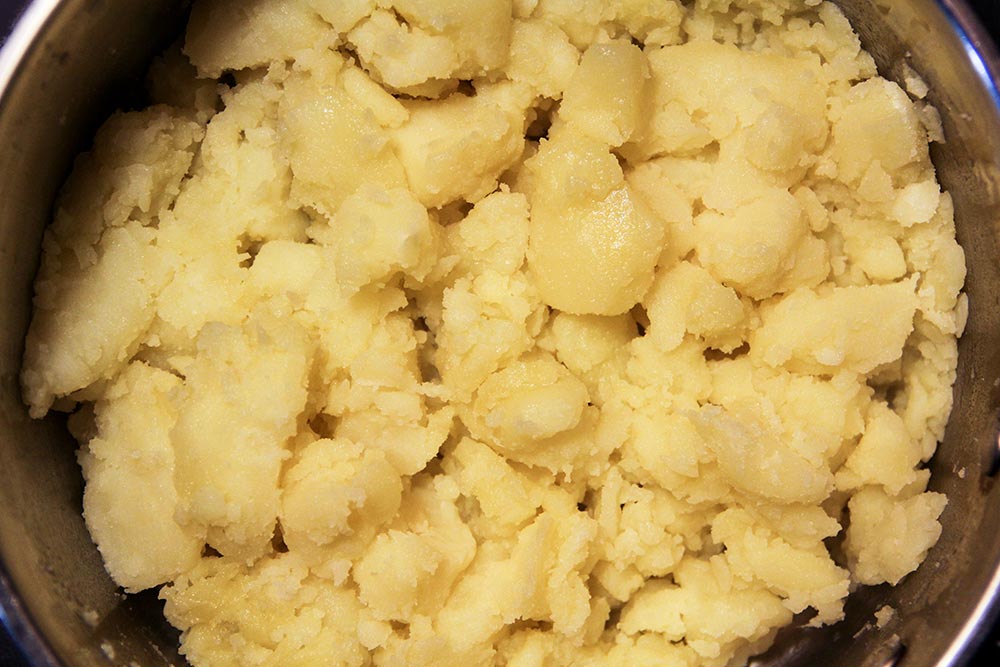
Cutting & Adding Scallions
In Gordon’s recipe, he calls for “Spring Onions.” Since my grocery store had “Green Onions,” I substituted. I looked to see what the difference is between the two types of onions is and here is what I discovered: green onions and scallions are the same thing. Spring onions have a stronger taste than them. You can substitute green for spring, but not the other way around because spring may be too much.
Since I had a bunch of onions, I cut them all up and added them to the potatoes.

I also learned that you use almost the entire onion. The only areas you don’t use are the root ends. And according to Ramsay, you should be generous with these.
After the onions were in the saucepan with the potatoes, I added a few pinches of salt and some ground up black pepper. This is to taste, so start tasting.
Adding the Crab Meat
This is where there is some debate. The debate revolves around whether you should add canned crab meat or fresh crab meat to a recipe like this. I think this is a dirty little secret for many of us. I, for one, would love to eat only fresh crab meat. The thing is, I’m not the type to pick through a crab to get it. I understand there are many different qualities of meat out there and many of the high quality types come in cans, so for this recipe today, I purchased two 6 ounce cans of crab meat and added them to the potato mixture.
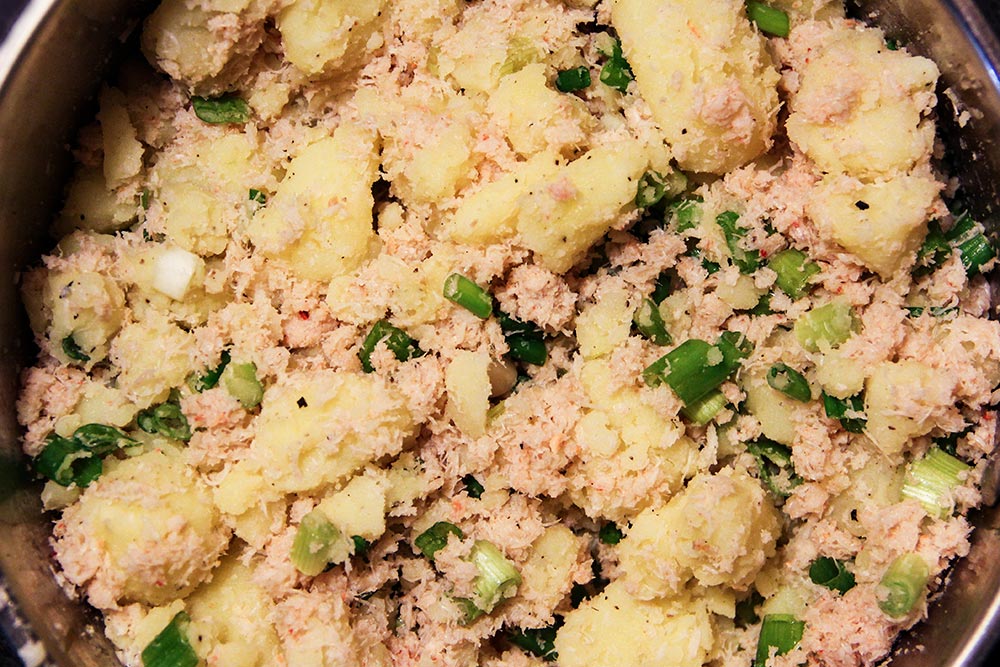
I believe more folks lean toward the canned option.
Making & Adding the Vinaigrette
In Gordon’s recipe, he calls for a vinaigrette that’s made from olive oil, water, lemon juice, salt and pepper. He doesn’t, however, tell us the ratio of each ingredient. It was up to me to find out. Also, I wanted to know why these dressings are sometimes called “vinaigrette” when they have no vinegar in them.
Let’s look at the naming issue first. Upon a bit of research on this topic, I’ve come to discover that Gordon’s recipe isn’t actually a “vinaigrette.” It’s a “citronette.” Well, it’s really called a lemon vinaigrette, but another fellow who writes about food has decided on the latter name. I tend to agree with him.
Next up is the ratio of lemon juice to olive oil. From what I’ve gathered, the ratio of acidic ingredient (lemon or balsamic vinegar) to olive oil is one to three. You can also add the same amount of water as you did lemon juice. After that, add a pinch of salt and a similar amount of pepper and whisk it all together in a bowl. If you have a shaker or a plastic bottle (like I plan to get), put the ingredients in that and shake it up. Finally, add a liberal amount of your mixture to the potato salad.
Adding Parsley
The last ingredient I’m going to add to this potato salad is my parsley. In Gordon’s recipe, he adds coriander. Personally, I don’t care for coriander and I really enjoy parsley, so parsley it is. And as I mentioned in the “Ingredients” section of this post, I used 1/2 cup. I may have actually gone over that because I used extra potatoes.
Now, if you read my post on how to chop parsley, you’ll remember that it needs to be chopped with a very sharp knife. You don’t want to bruise the herb at all – you merely want to slice right through it. The parsley should remain dry and have very distinct cuts.

Once I had the parsley chopped, I added it to the potato salad.
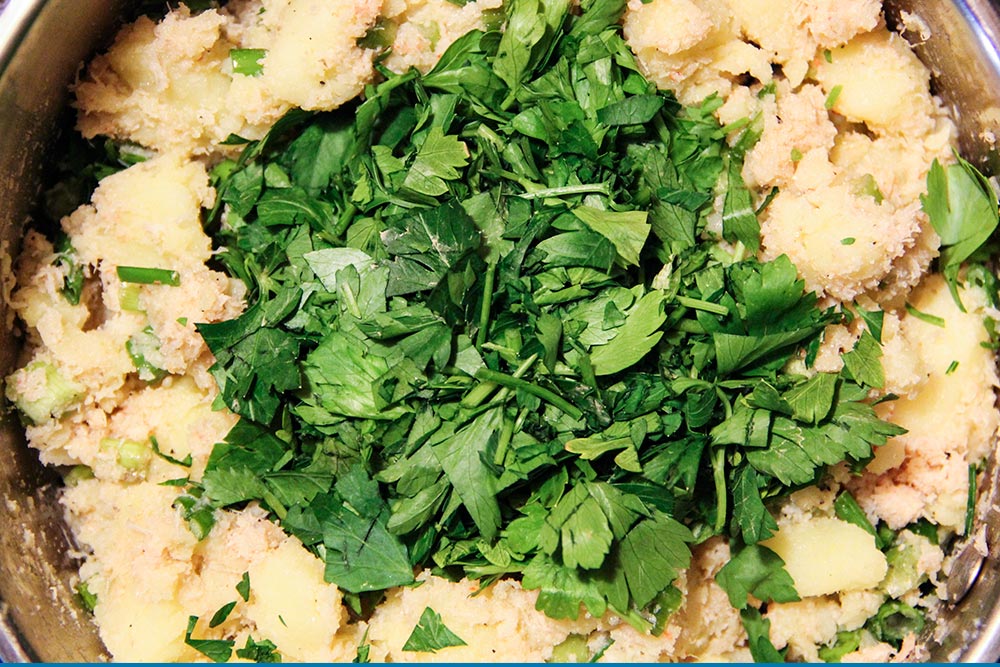
And finally after that, I stirred all the ingredients together one last time.
Preparing the Tomatoes
I used four plum tomatoes, since they were larger than the grape variety. If you’ve got grape tomatoes, go ahead and use a larger number. The more the better. Since this is an isolated ingredient, it’s really up to you to know your limit.
Basically, I halved the tomatoes, sprinkled them with salt and pepper and placed them in the oven at 400 degrees. I kept my eye on them until they looked sufficiently dehydrated. I took the opportunity to do this while I was preparing and cooking the salmon (next).
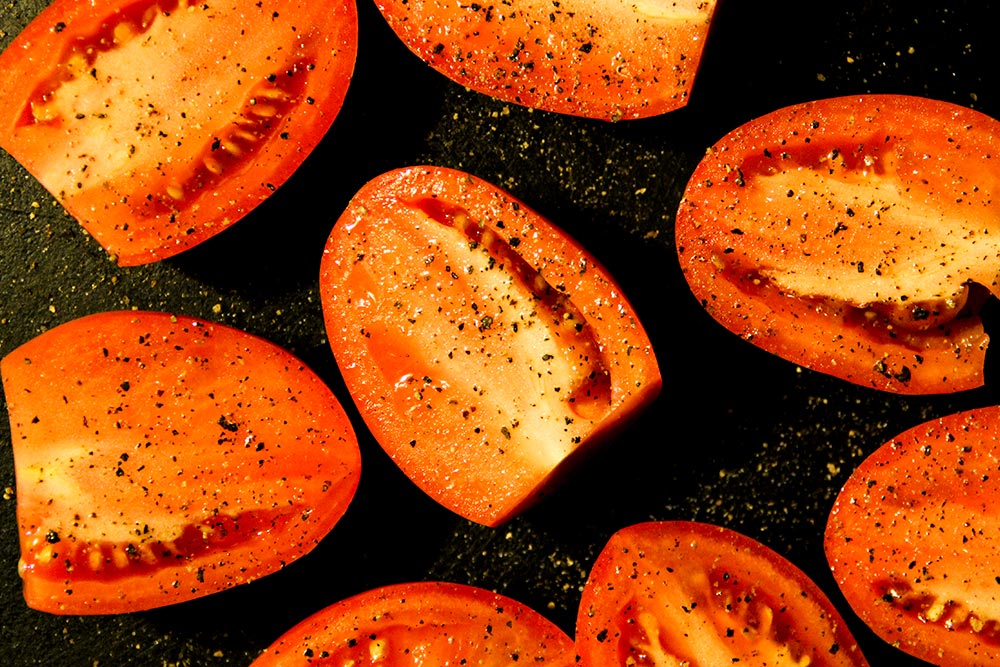
Preparing the Salmon
For this recipe, I used three skin-on salmon fillets. I cleaned both fillets under running water, dried them and then flipped them over on a plate so they were skin up. After that, I made a few slices with my chef’s knife across each fillet. I then sprinkled some sea salt in each slice. These slices will add to the crispiness and flavor of each fillet.
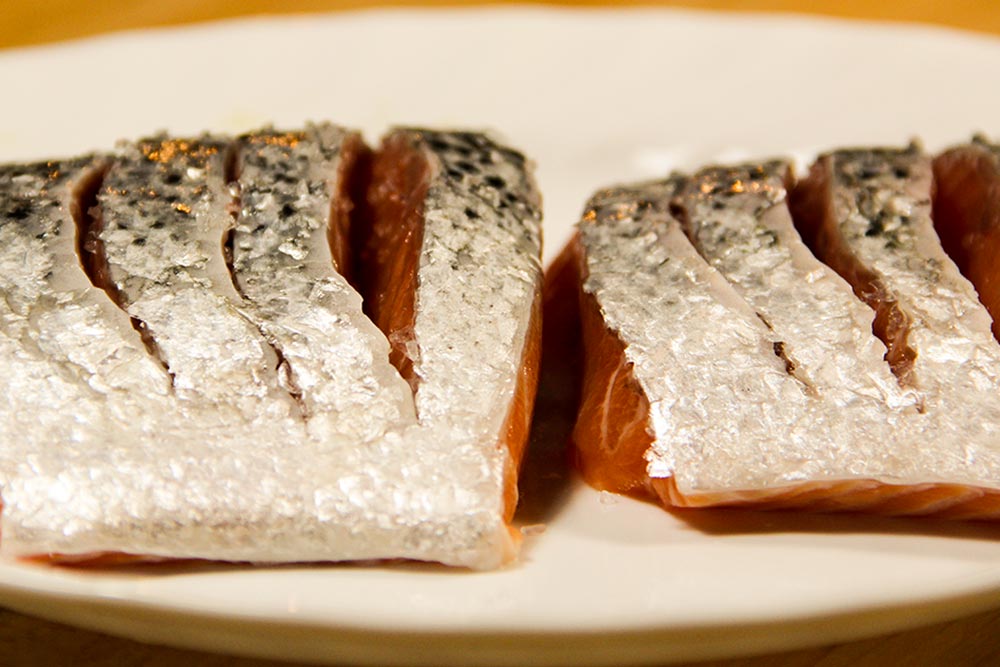
Directly after that, I drizzled some olive oil over each fillet and then began heating up my skillet.
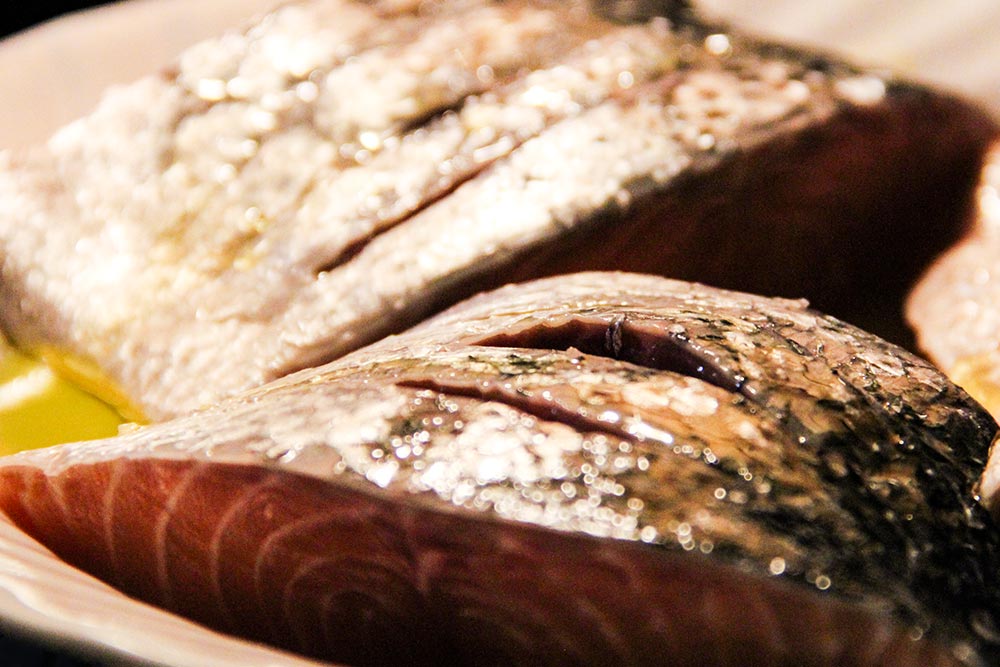
Sauteing the Salmon
The last major task that needed completion before plating this dish was actually cooking the salmon. I used the saute method in my All-Clad skillet until the skin side (which was down first) was perfectly brown and crispy. I then flipped the salmon over for just a few minutes and each fillet came out wonderfully.

I will tell you this: when cooking salmon, don’t use a stainless steel skillet. In the case of tonight’s dish, I wish I had used my cast iron. I’ve used that before to do the same type of fillet and it worked much better than this new skillet did. Fish sticks to stainless steel – period.
The Final Product
I’ll be honest with you here. This was a tough post to write. This was the first time I’ve attempted to prepare a dish like this while simultaneously taking photos, editing those photos and writing a blog post. It was difficult and it took hours to complete. I began this endeavor at 6PM this evening and right now, it’s 11:42PM. I was, however, rewarded with a beautiful meal.
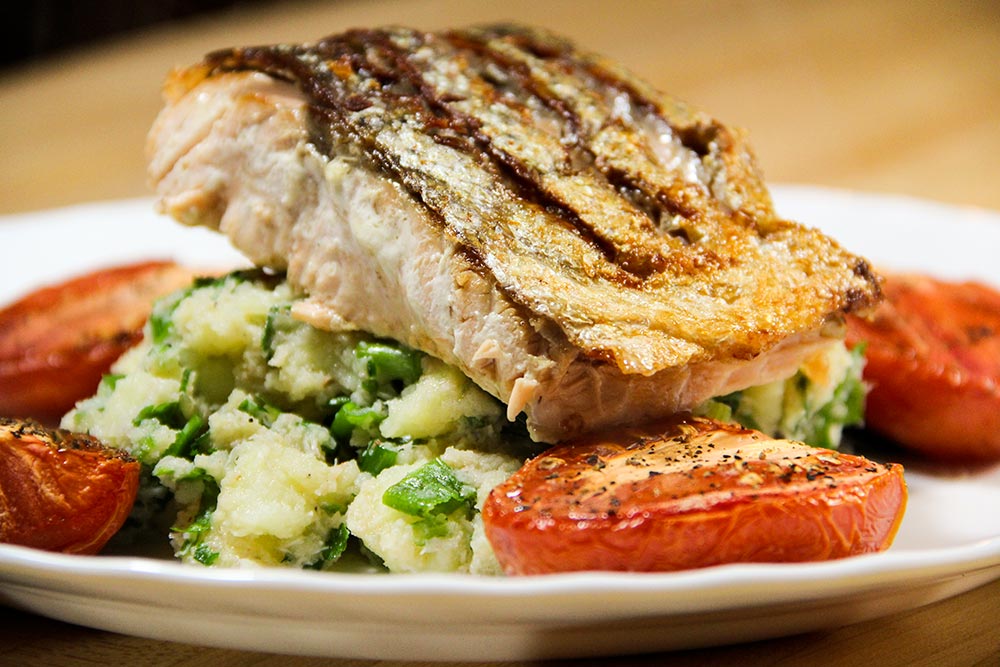
Laura and I just finished eating and wow – the salmon was nice and moist and the crab potato salad tasted wonderfully. Learning to cook certainly does have its perks.
Have you tried this recipe? If so, what did you think? Do you have any improvements, suggestions or substitutions? I’d love to hear about them in the comment section below.

Wow, Jay! That looks amazing! You are a pro!
Thank you!
Thank you Jay for your post. It really helped to answer all the questions I had about this recipe after seeing it on YouTube. You did a great job on your dish. I can’t wait to try the potato salad myself. Thank you again Jay, you have no idea how much you helped out this beginner. Wishing you the best of luck and the TASTIEST of dishes.
Thank you for this comment. I loved reading it. I’m glad you found my post helpful and I wish you the best. Good luck with all your recipes!
Nice post! I’ve been trying this method for salmon too and am worried I’m overcooking it (for safety reasons, obviously). I’m aiming for 145F on my food thermometer but I can’t get it there after just a few minutes on each side. What have you been doing to achieve ‘doneness’? Bring the fillets up to room temp first? Thanks in advance…. and keep up the great work!
Thanks! Yes, I always try to bring any salmon I’m cooking up to room temperature before doing anything with it. It’s remarkable how much raising the temperature of the salmon can do for the overall ease of cooking. I used to start cooking the salmon when it was still around 40 degrees and like you said, it’s tough to get it to finish correctly. Let yours sit out for a while and then give it a go in the pan. Let me know how it turns out.
I had made this Gordon Ramsey recipe ages ago based on a YouTube video that no longer exists, which was devastating because I remembered the results fondly. Thank you so much for preserving the recipe and walking us through the process, alongside your adjustments and thoughts, which was super helpful. You were able to replace that video with effective text, which is great for being able to scroll to specific parts as opposed to having to rewind and fast forward in a video while trying to cook at the same time (pure chaos!). Great post, and great pics! Thanks for sharing.
Thank you for this incredible comment. It’s probably the best one I’ve ever received.